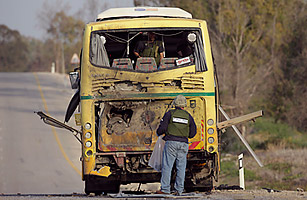
Israeli officials say it so often they’ve taken to apologizing for using the example, acknowledging it’s become a clich: Israel and Hamas can lob shells into and out of the Gaza Strip indefinitely without risking actual war, the explanation begins. Each side wants to appear tough, and over four years the call and response has grown as delicately calibrated as a minuet. But should one of Hamas’ hastily fired, unguided rockets happen to land on a kindergarten, all bets are off.
So more than one kind of madness appeared to be operating Thursday when a Hamas fire team in Gaza aimed an anti-tank missile at a big yellow school bus on the Israeli side, and pulled the trigger. The heat-seeking missile struck the rear of the vehicle, leaving the only student on board, a 16-year-old boy, with a critical head wound, and the Israeli government under intense pressure to take the conflict to another level. See pictures of life under Hamas in Gaza.
“The main parameter that will define these things is civilian casualties,” says Ofer Zalzberg, an analyst for the International Crisis Group, on the subject of tensions already mounting so steadily that a briefing paper — “Gaza: The Next Israel-Palestinian War?” — came out two weeks ago. “Civilian casualties are translated into popular anger, which creates pressure on the government, and it becomes more difficult to respond with only what they call limited, surgical attacks.”
Indeed, on Friday, Prime Minister Benjamin Netanyahu declared that the bus attack “crossed the line” and hinted more strikes will be forthcoming beyond Israel’s immediate response. Artillery and air strikes wounded three on Thursday, and the next morning killed five. In addition to two militants, Friday’s fatalities included an elderly man, a housewife and her daughter.
The spiral toward war tightens even though by every account neither Israel nor Hamas actually wants one. Operation Cast Lead, as Israelis called the bombardment and incursion on the eve of President Obama’s inauguration, cost the militant Islamist government, by its own account, some 700 fighters, and the Jewish State another layer of a hide that is remarkably thick but not impervious to international outrage. The criticism cascaded in with coverage of the three-week bombardment, and the resulting hundreds of civilian deaths.
“I must say the next Cast Lead operation will not be the same,” a senior Israeli officer in the Southern Command told TIME last year, when the informal truce that followed the assault was still holding. “Cast Lead One was just a small part of the IDF’s power. The next time it will be harder and more painful than the last one. Eighty percent percent will not be withheld in the next attack.” See TIME’s video “Israel’s Lonesome Doves.”
Both Israeli officials and Palestinian analysts say Hamas takes the threat seriously. It also has political reasons to protect the status quo. The overthrow of Hosni Mubarak in Egypt at once removed an enemy and held out the hope that the Muslim Brotherhood, the Islamist party that inspired Hamas, will play a prominent role in the government that succeeds him. That possibility dovetails with the plans of Hamas’ more moderate members to lay a broader claim to representing the Palestinian cause. “We are a moderate Islamist movement,” Hamas spokesman Tahar al-Nunu told TIME recently in Gaza City. “The Europeans are starting to listen to us. Before they used to hear about Hamas. Now they hear from Hamas. Last year I was in Zurich with a Hamas delegation. They have a change of understanding.”
At the same time, groups more militant than Hamas constantly pressure the governing party to live up to its name, which is an acronym of the arabic for the Islamic Resistance Movement. Islamic Jihad, the Army of Islam and other jihadi factions have drawn young fighters from Hamas as its political wing, at least, has grown more staid under the obligations of governance.
If, as one Gaza analyst suggests, Hamas must launch mortars in order to maintain sufficient credibility to control the groups, al-Nunu stood ready with rhetorical justification. “The Israelis choose the way we deal with them,” he says. “If they give us our rights, we won’t use weapons or violence. If they use weapons against us, don’t imagine that we can let our people die alone. If I go to hell, I’ll take them with me.” With that, the official spokesman announced a cease-fire was taking effect. It held no longer than the one Hamas announced Thursday night.
“The difficulty is both sides are employing the logic of deterrence, so once attacked they think they have to attack,” says Zalzberg. “De-escalation happens if both sides have demonstrated enough that they can say, ‘We’ve shown the other side.’ Escalation can happen when they miscalculate.”
On the Israeli side, the calculations include an understanding that deterrence is aimed at enemies beyond Hamas. Both Iran and Hizballah, its client militia that has some 40,000 missiles in Lebanon, on Israel’s northern border, are assumed to be monitoring Israel’s response, and calculating the implications for themselves. “Once the word ‘Iran’ is mentioned, it changes the way Israeli decision makers are thinking,” Zalzberg says.Yet another layer of complexity arrives with the “Iron Dome,” a missile defense system designed to knock short range projectiles out of the sky. Originally set up to protect military bases, Israel has deployed it outside cities within rocket range of Gaza because of intense public pressure. On Thursday, it knocked down a Grad missile en route to the port city of Ashkelon. But at a reported cost of $50,000 per intercepting missile, the expense of the system may argue for a more conventional military solution.
Meanwhile, as Israel Defense Forces drones, warplanes and helicopter gunships buzzed over the Gaza Strip, Hamas urged militants to protect themselves as follows: steer clear of security sites and shut off your cell phones.
See the 2011 TIME 100 Poll
See the 140 Best Twitter Feeds